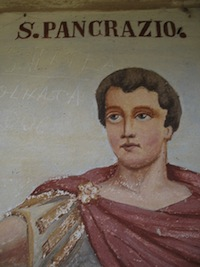St Pancras

Martyr. Little is certainly known of the life of Saint Pancras. According to legend, he came from Phrygia and was martyred in Rome at the age of 14 during the persecution under Diocletian.
His parents were said to be of Roman citizenship. His mother Cyriada died during childbirth, while his father Cleonius died when Pancras was eight years old. Pancras was entrusted to his uncle Dionysius' care. They both moved to Rome to live in a villa on the Caelian Hill. They both converted to Christianity. During the persecution of Christians by Diocletian, around 303 AD, he was brought before the authorities and asked to perform a sacrifice to the Roman gods. Pancras refused and eventually was beheaded.
A Roman matron named Ottavilla recovered his body, covered it with balsam, wrapped it in precious linens, and buried it in a newly built sepulchre dug in the Catacombs of Rome. Pancras' head was placed in a reliquary that still exists today in the Basilica of San Pancrazio.
A church was built over his tomb in 500 by Pope St Symmachus. In 664 some of his relics were sent to the king of Northumbria by Pope Vitalian. He is mentioned by Bede.
Six ancient churches in England were dedicated to him, including one by St Augustine of Canterbury. The parish of St Pancras in London gave the name to the old borough and the railway station as well as a 19th century church on Euston Road. The more historic Old St Pancras Church, on an ancient site, behind the station still survives.












